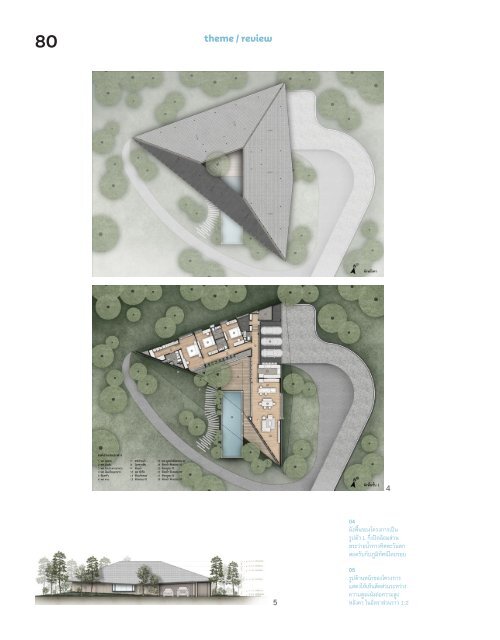ASA JOURNAL 12/2023
You also want an ePaper? Increase the reach of your titles
YUMPU automatically turns print PDFs into web optimized ePapers that Google loves.
theme / review<br />
THE FIFTH ELEMENT<br />
80 81<br />
The roof has emerged as a significant architectural element<br />
in shaping and diversifying the form and scope of architecture.<br />
It serves as the “fifth façade,” linking, exposing, and enveloping<br />
the space that exists between architecture and its surrounding<br />
environment, thereby facilitating a dialogue between the empty<br />
space and the contextual setting of the site.<br />
6<br />
5<br />
4<br />
04<br />
ผังพื้นของโครงการเป็น<br />
รูปตัว L กึ่งปิดล้อมส่วน<br />
สระว่ายน้ำาทางทิศตะวันตก<br />
สอดรับกับภูมิทัศน์โดยรอบ<br />
05<br />
รูปด้านหน้าของโครงการ<br />
แสดงให้เห็นสัดส่วนระหว่าง<br />
ความสูงผนังต่อความสูง<br />
หลังคา ในอัตราส่วนราว 1:2<br />
06<br />
ทัศนียภาพจากพื้นที่สวน<br />
ฝั่งทิศตะวันตกหันเข้า<br />
สู่พื้นที่หลังคาระแนง<br />
ขนาดใหญ่<br />
“The roof is a transformative element. It has the<br />
power to redefine our perception of space and<br />
create unique experiences within architecture.<br />
It can act as a fifth façade, opening up new possibilities<br />
for interaction with the built environment.”<br />
The quoted statement is attributed to Dutch architect<br />
Rem Koolhaas, who defines the architectural<br />
element in his renowned book on theories of architecture,<br />
“S, M, L, XL.”<br />
The roof constitutes a fundamental architectural<br />
element. Its contributions to a built structure include<br />
providing protection from sunlight and rain to its<br />
interiors. The roof has traditionally been defined<br />
based on its functional dimension, which has been<br />
considered a fundamental aspect of its meaning.<br />
However, the concept of the roof encompasses a<br />
multitude of meanings and definitions that extend<br />
beyond its utilitarian merits and cannot be completely<br />
explained solely from this perspective. The boundaries<br />
in regards to possible definitions of a roof<br />
have expanded to encompass symbolic interpretation,<br />
cultural reflection, and ways of life. The roof<br />
has emerged as a significant architectural element,<br />
playing a crucial role in shaping and diversifying<br />
the form and scope of architecture. It serves as the<br />
“fifth façade,” linking, exposing, and enveloping<br />
the space that exists between architecture and its<br />
surrounding environment, thereby facilitating a dialogue<br />
between the empty space and the contextual<br />
setting of the site. The Makmuan House, located in<br />
the Sri Chom Phu district of Thailand’s Khon Kaen<br />
province, presents an intriguing case study on the<br />
influence of roof design in contemporary architectural<br />
works.


















